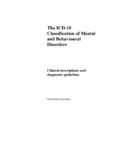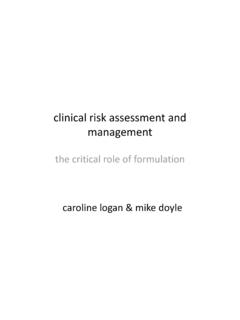Transcription of ACEM POLICY DOCUMENT – GUIDELINES FOR …
1 ACEM POLICY DOCUMENT . GUIDELINES FOR implementation OF THE AUSTRALASIAN TRIAGE. SCALE IN EMERGENCY DEPARTMENTS. 1. GENERAL PRINCIPLES. Function of triage Triage is an essential function in Emergency Departments (EDs), where many patients may present simultaneously. Triage aims to ensure that patients are treated in the order of their clinical urgency and that their treatment is appropriately timely. It also allows for allocation of the patient to the most appropriate assessment and treatment area, and contributes information that helps to describe the departmental casemix. Urgency refers to the need for time-critical intervention it is not synonymous with severity. Patients triaged to lower acuity categories may be safe to wait longer for assessment and treatment but may still require hospital admission. The Triage Assessment The features used to assess urgency are generally a combination of the presenting problem and general appearance of the patient, possibly combined with physiological observations.
2 The triage assessment should generally take no more than two to five minutes, obtaining sufficient information to determine the urgency and identify any immediate care needs. This does not preclude the initiation of investigations or referrals at this point. There must be a balance between speed and thoroughness. The triage assessment is not necessarily intended to make a diagnosis, although this may sometimes be possible. Vital signs should only be measured at triage if required to estimate urgency, or if time permits. Any patient identified as ATS Category 1 or 2. should be taken immediately into the appropriate assessment and treatment area. A more complete nursing assessment should be done by the treatment nurse receiving the patient. In Australasia, triage is carried out by emergency nurses. As triage is so important to both the smooth running of an ED and the outcome of the patients, it should be carried out by staff who are both specifically trained and experienced.
3 Safety at Triage Triage is the first point of public contact with the ED. Patients with the whole spectrum of acute illness, injury, mental health problems and challenging behaviour may present there. Pain, anxiety and/or intoxication in patients or their relatives may provoke or magnify aggressive behaviour. These factors may create a risk of harm for the triage nurse and other reception staff. It is essential that all EDs plan for this potential risk by providing a safe but non- threatening physical environment, providing minimisation-of-aggression training to front-line staff, and having safe protocols and procedures for dealing with challenging behaviour. Where the safety of staff and/or other patients is under threat, staff and patient safety should take priority and an appropriate security response should take place prior to clinical assessment and treatment.
4 Time to Treatment The time to treatment described for each ATS Category refers to the maximum time a patient in that category should wait for assessment and treatment. In the more urgent categories, assessment and treatment should 2. occur simultaneously. Ideally, patients should be seen well within the recommended maximum times. Implicit in the descriptors of Categories 1 to 4. is the assumption that the clinical outcome may be affected by delays to assessment and treatment beyond the recommended times. Further research is still required to describe the precise relationship between the time to treatment and the clinical outcome. The maximum waiting time for Category 5. represents a standard for service provision. The recommended performance thresholds represent realistic practice constraints in the clinical environment. However, there is no implied justification for prolonged delays for patients falling outside the required performance standards all attempts should be made to minimise delays.
5 Practicality and Reproducibility The primary and most important role of triage is clinical. Therefore application of the ATS must occur in such a way that ensures patient safety and maximises flow through the emergency department. While it is desirable to attempt to maximise inter-rater reliability for reasons of inter-departmental comparisons and for casemix purposes, it must be recognised that no clinical coding system achieves perfect reproducibility. Acceptable levels of inter-rater agreement have been defined which allow for a realistic balance between clinical practicality and classification. 2. EXTENDED DEFINITIONS AND EXPLANATORY NOTES. Arrival Time The arrival time is the first recorded time of contact between the patient and Emergency Department staff. A recording accuracy to within the nearest minute is appropriate. There should be no delay between the physical arrival in the ED of a patient who is seeking care and their first contact with staff.
6 Time of Medical Assessment and Treatment Although important assessment and treatment may occur during the triage process, this time represents the start of the care for which the patient presented. A recording accuracy to within the nearest minute is appropriate: Usually it is the time of first contact between the patient and the doctor initially responsible for their care. This is often recorded as Time seen by doctor . Where a patient in the ED has contact exclusively with nursing staff acting under clinical supervision of a doctor, it is the time of first nursing contact. This is often recorded as Time seen by nurse . Where a patient is treated according to a documented, problem specific clinical pathway, protocol, or guideline approved by the director of Emergency Medicine, it is the earliest time of contact between the patient and staff implementing this protocol.
7 This is often recorded as the earlier of Time seen by nurse or Time seen by doctor . Waiting Time This is the difference between the time of arrival and the time of initial medical assessment and treatment. A recording accuracy to within the nearest minute is appropriate. Performance Indicator Thresholds Where a patient has a waiting time less than or equal to the maximum waiting time defined by their ATS category, the ED is deemed to have achieved the ACEM_IG_APPROVED. 3. performance indicator for that presentation. Achievement of indicators should be recorded and compared between large numbers of presentations. Documentation Standards The documentation of the triage assessment should include at least the following essential details: Date and time of assessment Name of triage officer Chief presenting problem(s). Limited, relevant history Relevant assessment findings Initial triage category allocated Retriage category with time and reason Assessment and Treatment area allocated Any diagnostic, first aid or treatment measures initiated Re-triage If a patient's condition changes while they are waiting for treatment, or if additional relevant information becomes available that impacts on the patient's urgency, the patient should be re-triaged.
8 Both the initial triage and any subsequent categorisations should be recorded, and the reason for the re- triage documented. 3. SPECIFIC CONVENTIONS. In order to maximise reproducibility of ATS allocation between departments, the following conventions have been defined: Paediatrics The same standards for triage categorisation should apply to all ED settings where children are seen whether purely Paediatric or mixed departments. All five triage categories should be used in all settings. This does not preclude children being seen well within the recommended waiting time for the ATS. Category if departmental POLICY and operational conditions provide for this. However, for the sake of consistency and comparability, children should still be triaged according to objective clinical urgency. Individual departmental policies such as "fast-tracking" of specific patient populations should be separated from the objective allocation of a triage category.
9 Trauma All victims of trauma should be allocated a triage category according to their objective clinical urgency. As with other clinical situations, this will include consideration of high-risk history as well as brief physical assessment (general appearance +/- physiological observations). Although individual departments may have policies that provide for immediate team responses to patients meeting certain criteria, these patients should still be allocated an objective triage category according to their clinical presentation. Again, departmental "fast-tracking" policies or systems should occur separately to the objective allocation of a triage category. Behavioural Disturbance Patients presenting with mental health or behavioural problems should be triaged according to their clinical and situational urgency, as with other ED. patients. Where physical and behavioural problems co-exist, the highest ACEM_IG_APPROVED.
10 4. appropriate triage category should be applied based on the combined presentation. While some acutely-disturbed patients may require an immediate clinical response (perhaps combined with a security response) to ensure their safety, it is recognised that some individuals entering an emergency department and posing an immediate threat to staff (eg brandishing a dangerous weapon). should not receive a clinical response until the safety of staff can be ensured. In this situation, staff should act so as to protect themselves and other ED. patients, and obtain immediate intervention from security staff and/or the police service. Once the situation is stabilised, a clinical response can take place as (and if) required, and triage should then reflect clinical and situational urgency. 4. CLINICAL DESCRIPTORS. Source The listed clinical descriptors for each category are based on available research data where possible, as well as expert consensus.





